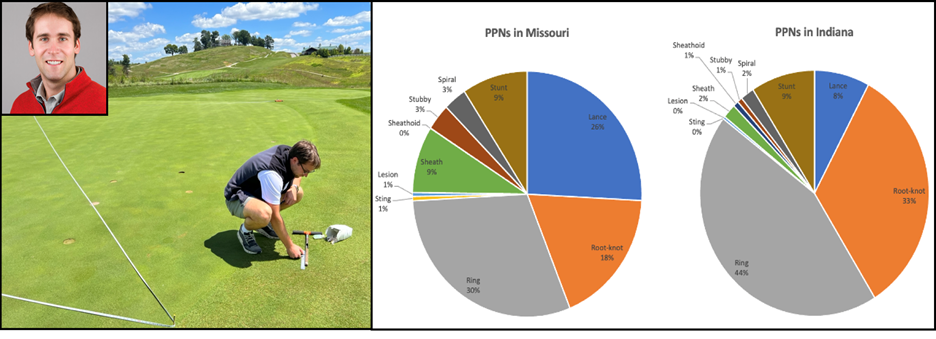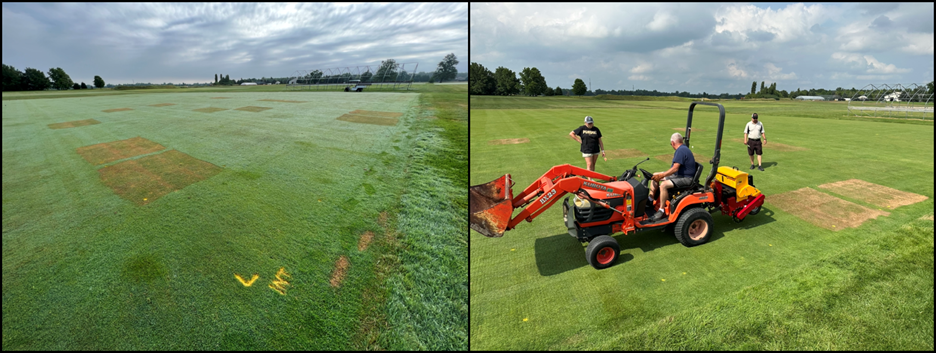Nematology: The Purdue Turfgrass Pathology Program recently graduated Asa McCurdy, M.S. following his research scouring the state last year to assess nematode populations on golf putting greens. Asa sampled 10 golf courses throughout Indiana to continue his previous research sampling from 10 courses in Missouri/KC. To our knowledge, this is the first broad systematic nematode survey on golf putting greens throughout this region. While more plant parasitic nematodes where found in Indiana, the distribution was quite different. Root-knot nematodes were discovered in significantly higher numbers in Indiana than in Missouri, while Missouri had approximately three times as many lance nematodes as found in Indiana. Nematode populations may vary considerably among sites, but this broad snapshot may indicate that the more problematic lance nematode may not be as widely distributed throughout Indiana.

New Faces/New Projects: Two new students, Mariah Cashbaugh and Justice Ruwona, began their Ph.D. degree research this summer and fall, respectively. Mariah will be investigating methods of soilborne pathogen detection on golf putting greens, with the goal of tracking pathogen inoculum as it occurs seasonally through the rhizosphere. In doing so, we hope to build a foundation for a biosurveillance system that may dynamically measure pathogen inoculum and along with environmental thresholds determine the best timing and site for preventive fungicide applications. This is a long-term project with a ways to go, but if no one starts it, no one can finish.

Justice Ruwona is working on a more traditional applied research project evaluating interseeding methods for conversion of golf fairways to bentgrass cultivars with enhanced dollar spot resistance. Considerable breeding efforts from multiple institutions have resulted in multiple lines of creeping bentgrass cultivars with improved dollar spot resistance. These successes have not been widely due to the cost and difficulty of closing the course for renovation, and previously failed attempts to achieve conversion on golf putting greens without complete renovation.
Interseeding: On July 6, we implemented a multifactor field experiment designed to evaluate the effectiveness of interseeding three dollar spot resistant cultivars along with four different herbicide/PGR treatments, glyphosate (complete renovation), and no herbicide. Next season, we will implement a five dollar spot fungicide application threshold on half each plot and leave the other half completely up for full disease pressure. Unique to this study, we can determine the return on investment for these conversion programs by calculating the fungicide savings over time resulting from conversion to dollar spot resistant cultivars. Also unique, this field experiment is being replicated at two other locations with colleagues at the University of Wisconsin (Dr. Paul Koch) and Penn State University (Dr. John Kaminski). Also unique, we have partnered with the USDA-ARS (hoping for no government shutdown!) to analyze the conversion success with genetic molecular markers from clippings sampled from each plot. Last, but not least, we have been uniquely gifted by great partners in this research including seed suppliers DLF Pickseed, Vista Seed Partners, and Tee 2 Green, and agrochemical suppliers FMC, Syngenta, NuFarm and Poacure. A special shout out and debt of gratitude for Sam Stimmel, Bill Brown and Aqua Aid Solutions (see below). Sam didn’t simply loan us a Vredo Turf-Fix interseeder for this research, but facilitated delivery and expertly operated it at all three sites (IN, WI, and PA) across a 10-day span. We greatly appreciate your efforts.


